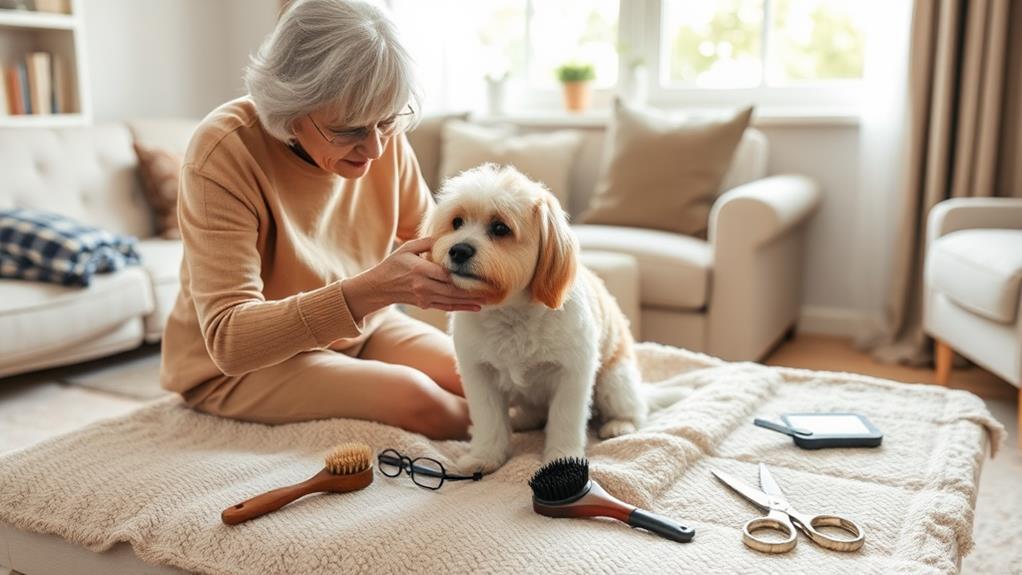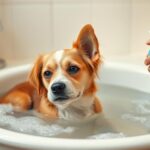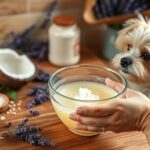Grooming your elderly or disabled dog takes a gentle approach tailored to their needs. Start by checking their physical condition and consider shorter grooming sessions to avoid discomfort. Use tools like a slicker brush and grooming gloves for effective, pain-free brushing, focusing on sensitive areas like paws and ears. During baths, opt for lukewarm water and a non-slip surface to keep them stable and relaxed. Regularly inspect their coat for matting and potential health issues, and consult your vet if you notice any unusual changes. Follow these tips, and you'll discover even more helpful advice for keeping your furry friend happy.
Understanding Special Grooming Needs
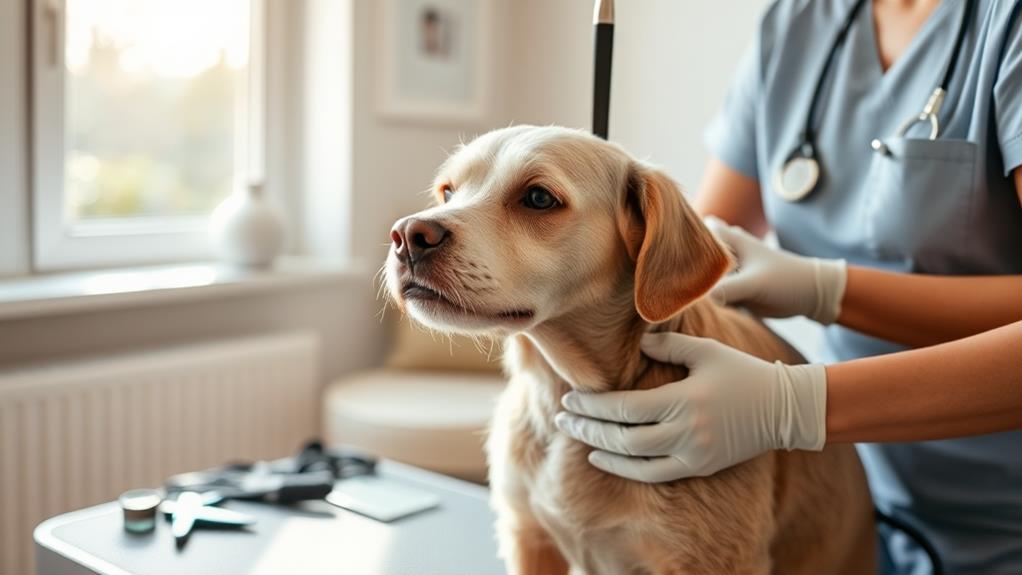
When it comes to grooming elderly or disabled dogs, understanding their distinctive needs is critical. These dogs often face mobility issues or health concerns that can make regular grooming challenging. You'll want to approach grooming with patience and care, creating a calm environment where your dog feels secure.
First, assess your dog's physical condition. If they've arthritis or any joint issues, opt for shorter grooming sessions to avoid discomfort. Pay special attention to sensitive areas, like their paws, ears, and skin folds, which may require extra care. Regularly check for matting in their fur, as this can lead to skin irritations.
You should also consider their sensory abilities. Older dogs may have diminished sight or hearing, so gentle, reassuring touches can help them feel more at ease during grooming. Always speak softly and encourage them, as this can make a significant difference in their comfort level.
Lastly, keep an eye on their overall health. If you notice any unusual lumps, bumps, or skin changes while grooming, consult your veterinarian. By being attentive to their unique needs, you'll guarantee that grooming remains a positive experience for your beloved companion.
Tools for Effective Grooming
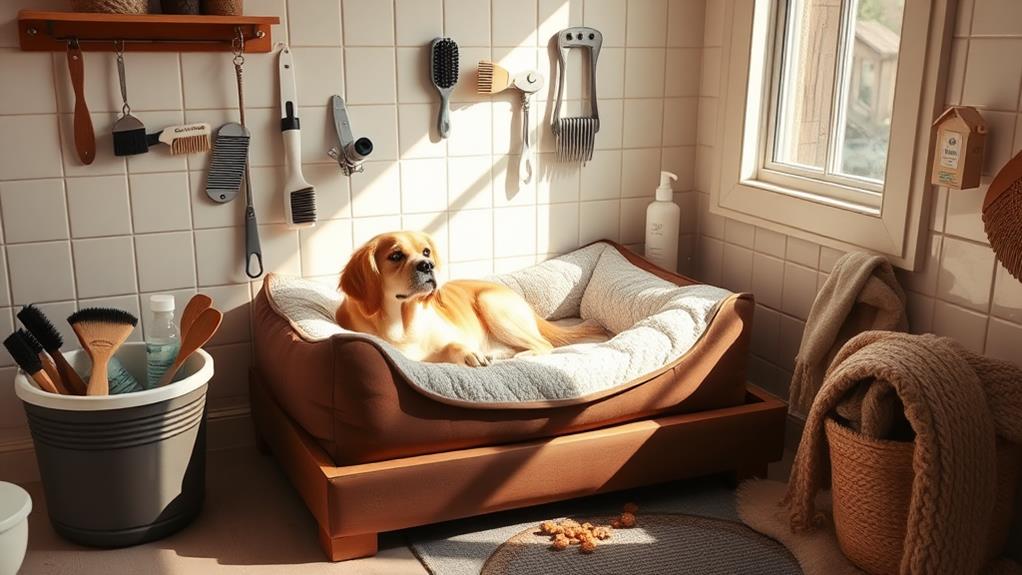
Choosing the right tools can make a significant difference in the grooming experience for elderly or disabled dogs. Selecting ergonomic, user-friendly tools will not only ease the process for you but also make it more comfortable for your furry friend.
Here's a quick overview of essential grooming tools:
| Tool | Purpose |
|---|---|
| Slicker Brush | Removes loose fur and tangles |
| Undercoat Rake | Targets thick undercoats for better results |
| Nail Clippers | Keeps nails trimmed and prevents discomfort |
| Grooming Gloves | Provides a gentle way to remove loose hair |
| Soft Bristle Brush | Ideal for sensitive skin and final touches |
Using these tools can help you maintain your dog's coat while minimizing stress. Always consider your dog's specific needs, as some may require more gentle handling than others. Prioritize comfort by ensuring tools fit well in your hands, reducing strain during grooming sessions. With the right equipment, you'll create a more enjoyable and effective grooming routine, fostering a positive bond with your elderly or disabled companion.
Bathing Techniques for Comfort
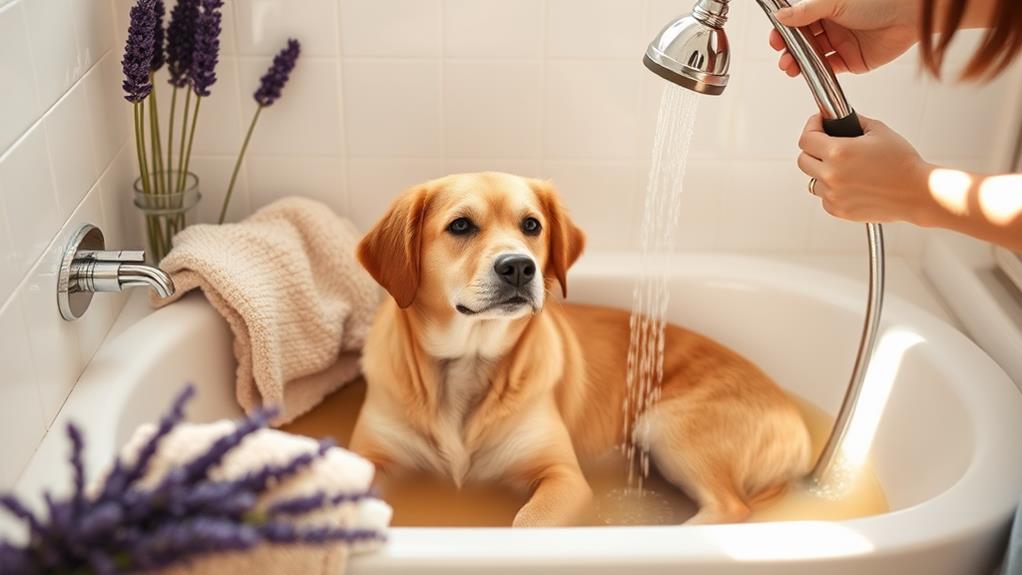
Bathing your elderly or disabled dog can be a gentle experience with the right techniques. You can make this process more comfortable by following a few simple steps.
- Use lukewarm water: It's soothing and helps prevent discomfort.
- Choose a non-slip surface: This provides stability and reduces anxiety for your dog.
- Use gentle, dog-friendly soap: Opt for a mild, hypoallergenic shampoo to guarantee no skin irritation.
Start by preparing everything you need before bringing your dog to the bathing area. Use a handheld showerhead or a cup for more control over the water flow. Speak softly to reassure your dog as you wet their coat, avoiding direct spray to the face. Gently lather the shampoo, paying extra attention to sensitive areas such as the belly and paws. Rinse thoroughly to confirm no soap residue remains.
After bathing, wrap your dog in a warm towel to keep them cozy. If your dog is unable to stand, consider using a large basin or even a sink to make the process easier and safer. Remember, patience and love go a long way in making bath time a positive experience.
Managing Coat Maintenance
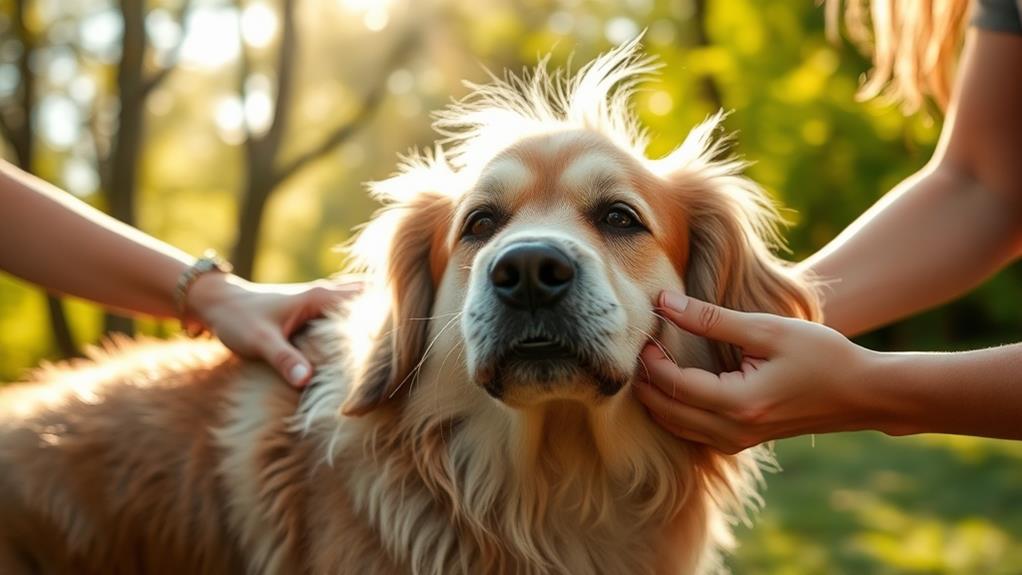
Maintaining your elderly or disabled dog's coat is essential for their overall well-being and comfort. Regular brushing is key to preventing matting and keeping their fur clean. Depending on your dog's breed, you might need to brush daily or a few times a week. Use a gentle brush that suits their coat type, and always be mindful of sensitive areas.
When you notice tangles, work through them slowly to avoid causing pain. A slicker brush or a comb can help with stubborn knots, but don't force it. If you encounter severe matting, you may need to consult a groomer for professional assistance.
Bathing your dog is also part of coat maintenance. Aim for a bath every month or as needed, using a mild dog shampoo to avoid skin irritation. Rinse thoroughly to guarantee no soap is left behind, which can cause discomfort.
Don't forget to check for any signs of pests like fleas or ticks, especially if your dog spends time outdoors. Keeping your dog's coat well-groomed not only enhances their appearance but also promotes better health and happiness. Regular maintenance routines will strengthen your bond and keep your furry companion feeling their best.
Addressing Health Considerations
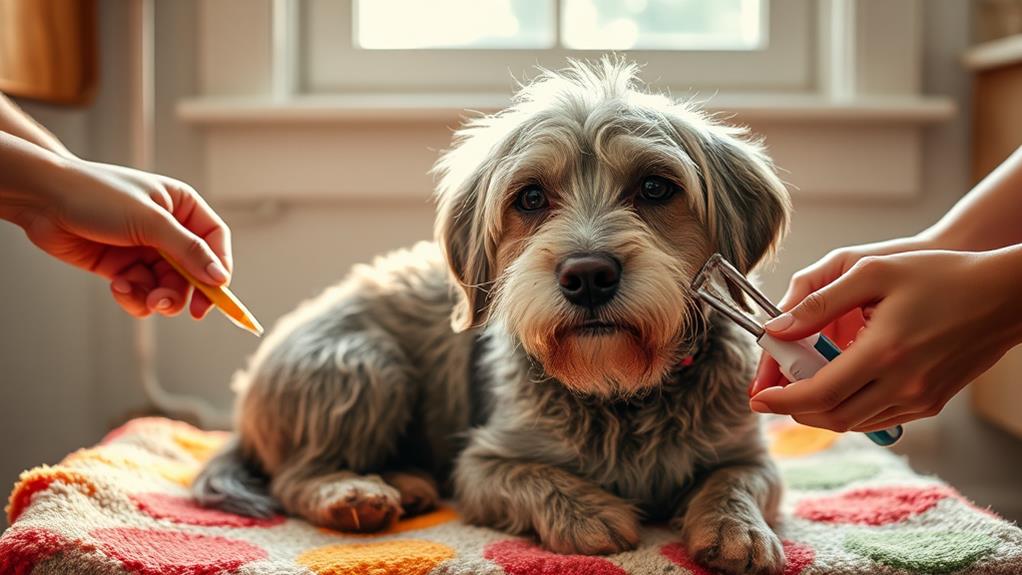
While keeping your dog's coat in good shape is important, it's also essential to pay attention to their overall health, especially as they age or face disabilities. Regular grooming can help you spot potential health issues before they escalate.
Consider these key health aspects:
- Skin Conditions: Check for dryness, redness, or lumps that could indicate allergies or infections.
- Mobility Issues: Be mindful of your dog's movement. If they seem stiff or reluctant to groom themselves, it might be time for a vet visit.
- Dental Care: Don't forget their teeth! Regular brushing can prevent dental diseases that are common in older pets.
Frequently Asked Questions
How Often Should I Groom My Elderly Dog?
You should groom your elderly dog regularly, ideally every few weeks. This helps maintain their coat's health and cleanliness, prevents matting, and allows you to check for any skin issues or discomfort they might have.
What Signs Indicate My Dog Dislikes Grooming?
Grooming can feel like a stormy sea for your dog. If they whine, pull away, or show signs of aggression, it's clear they're uncomfortable. Pay attention; their body language speaks louder than words.
Can I Groom My Dog at Home Safely?
Yes, you can groom your dog at home safely! Just guarantee you have the right tools, create a calm environment, and take breaks if needed. Always pay attention to your dog's cues to keep things stress-free.
How Can I Calm My Anxious Dog During Grooming?
To calm your anxious dog during grooming, create a relaxing environment. Use treats, soothing voices, and gentle touches. Take breaks, and gradually introduce grooming tools, ensuring your dog feels safe and comfortable throughout the process.
Are There Grooming Services Specialized for Elderly Dogs?
You might think specialized grooming services are hard to find, but they're becoming more common. Many groomers now cater specifically to elderly dogs, focusing on gentle techniques and comfort to guarantee a stress-free experience.
Conclusion
In caring for your elderly or disabled dog, remember that "a little kindness goes a long way." By understanding their unique grooming needs and utilizing the right tools and techniques, you can guarantee your furry companion feels comfortable and loved. Regular grooming not only keeps them looking their best but also supports their health and well-being. With patience and a gentle touch, you're creating a bond that enriches both your lives.

